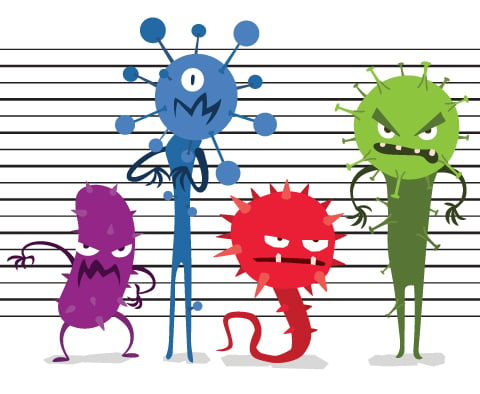Sinus Infections
A sinus infection, also known as sinusitis, is an inflammation, or swelling, of the tissue lining your sinuses, which are connected spaces in your head behind your forehead, eyebrows, cheeks, and nose. Your sinuses are normally filled with air but can become infected when they become blocked, and fluid builds up. This fluid buildup allows germs to grow. Bacteria as well as viruses and a fungus such as mold can cause a sinus infection.
An acute sinus infection can be caused by a common cold that lasts more than 10 days. A sinus infection with nasal congestion, drainage, facial pain, and decreased sense of smell lasting longer than 12 weeks despite medical treatment is considered chronic. The term recurrent acute sinusitis is used when your symptoms come back four or more times in one year and last less than two weeks each time.
Sinusitis affects about 31 million people in the US. People who have allergies, asthma, nasal polyps, or a deviated septum (which is when the cartilage and bone between the nostrils is off center) are at greater risk of infections. People with weak immune systems and smokers are also more likely to develop a sinus infection.
Americans spend more than $1 billion a year on over-the-counter medications and $150 million on prescription medications to find relief from sinus infections. These infections have led to 16 million doctor visits in the US.
Symptoms of a Sinus Infection
Common symptoms of a sinus infection/sinusitis include:
- Nasal inflammation
- Reduced smell and taste
- Difficulty breathing due to congested nose causing
- Thick, discolored mucus from the nose
- Drainage down the back of the throat
- Tenderness (pain) and swelling around eyes, cheeks, nose or forehead
- Ear Pain
- Headache
A bad cold is often mistaken for a sinus infection. Many symptoms are the same, such as nasal stuffiness or congestion, runny nose, coughing, and postnasal drip (mucus that drains down the back of the throat). Symptoms of a sinus infection that can help rule out a cold include nasal discharge that is greenish in color, pain or pressure in the front of your face, especially under your eyes or the bridge of your nose, or pain in your teeth. Fever, tiredness, and bad breath are also signs of a sinus infection.
MicroGenDX Test Used in Diagnosing Sinus Infections
An evaluation and culture (growing microbes from your sample in a lab) are often used to diagnose infections. However, standard cultures may come back negative even when you actually do have an infection, and that means your infection won’t be treated. Instead of relying on culture, a MicroGenDX test detects the DNA of all microbes in your sample, along with how much of each is present, and uses that information to identify the microbes in your infection and the drugs that can best treat it.
This test is included in the “SinusKEY ENT Test Service” test. You can order the test and get sampling instructions here:
https://microgendx.com/product/ent-sinus-test-service-dm-intl/
Providing a Sample for the Sinus Test
You will need to provide a nasal sample for this test. There are three ways to collect this sample; one method (nasopharyngeal swab) must be administered by trained qualified, clinical staff.
Everything you need to know about taking a sample is included with your test kit and is also available online on the product page. The instructions contain illustrations that will help you collect a sample without contaminating it. It’s very important to obtain a proper sample by following the instructions for collecting the sample, as well as when packaging and shipping it.
Medical Specialties Treating Sinus Infections
Sinus infections are treated by primary care providers and allergists. In some cases, your provider might refer you to an ear, nose, and throat (ENT) specialist or might order a CT scan.
How Sinus Infections Are Treated
Sinusitis is treated in several ways, depending on how severe it is. A mild sinusitis infection is treated with over-the-counter cold and allergy medications or nasal saline irrigation. You should not use nonprescription sprays or drops for longer than three to five days because they can increase rather than decrease congestion.
If symptoms of sinusitis don't improve after 10 days, your doctor may prescribe antibiotics or antifungal medications, oral or topical decongestants, or prescription steroid sprays.
Knowing what kind of bacteria, virus, or fungus is causing the infection can result in more effective therapy. It is important to know that not all antibiotics work for all bacteria, and some even work differently in different areas of the body. In addition, a fungal sinus infection should be treated with antifungal medication rather than antibiotics. Some forms of fungal sinus infections do not respond to antifungal medication and require the use of oral steroids instead. Your doctor should consult the "antimicrobials for consideration" chart on your MicroGenDX report to decide which treatment is right for you.
It is important to complete the full course of medication as it is prescribed, even when symptoms begin to clear up before you are treated. Rarely, you may develop resistance to specific antibiotics and cannot be effectively treated with those drugs. This is why all MicroGenDX diagnostic tests include detection of antibiotic resistance genes in your sample and provide alternative antibiotics for your doctor to consider prescribing to you.
References
- https://www.cdc.gov/antibiotic-use/sinus-infection.html
- https://acaai.org/allergies/allergic-conditions/sinus-infection/
- https://my.clevelandclinic.org/health/diseases/17701-sinusitis
- https://www.mayoclinic.org/diseases-conditions/acute-sinusitis/symptoms-causes/syc-20351671
- https://www.merckmanuals.com/professional/ear,-nose,-and-throat-disorders/nose-and-paranasal-sinus-disorders/sinusitis

